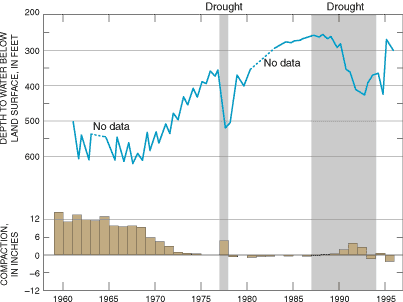
Sustainability of Ground-Water Resources--Circular 1186
The term "drought" has different meanings to different people, depending on how a water deficiency affects them. Droughts have been classified into different types such as meteorological drought (lack of precipitation), agricultural drought (lack of soil moisture), or hydrologic drought (reduced streamflow or ground-water levels). It is not unusual for a given period of water deficiency to represent a more severe drought of one type than another type. For example, a prolonged dry period during the summer may substantially lower the yield of crops due to a shortage of soil moisture in the plant root zone but have little effect on ground-water storage replenished the previous spring. On the other hand, a prolonged dry period when maximum recharge normally occurs can lower ground-water levels to the point at which shallow wells go dry.
Ground-water systems are a possible backup source of water during periods of drought. If ground-water storage is large and the effects of existing ground-water development are minimal, droughts may have limited, if any, effect on the long-term sustainability of aquifer systems from a storage perspective. In contrast, where ground-water storage and heads have been substantially reduced by withdrawals of ground water before a drought occurs, ground water may be less useful as a source of water to help communities and others cope with droughts. Furthermore, previous ground-water withdrawals can cause water levels and flows in lakes, streams, and other water bodies during droughts to be below limits that would have occurred in the absence of ground-water development. Likewise, reduced freshwater discharges to coastal areas during droughts may cause seawater to move beyond previous landward limits, or reduced heads in aquifers may cause renewed land subsidence (Figure B-1).

Figure B-1. Effects of drought on ground-water levels and associated subsidence in the San Joaquin Valley of California. (Modified from Galloway and Riley, in press; and Swanson, 1998.)
The San Joaquin Valley is a major agricultural area that produces a large fraction of the fruits, nuts, and vegetables in the United States. Ground-water withdrawals during the 1930's to early 1960's caused water-level declines of tens to hundreds of feet in much of the valley. The water-level declines resulted in compaction of the alluvial deposits and extensive land subsidence. Subsidence in excess of 1 foot has affected more than 5,200 square miles in the San Joaquin Valley, representing perhaps the largest anthropogenic change in land-surface elevation in the world. Importation of surface water, beginning in the 1960's, led to a decrease in ground-water withdrawals, which in turn led to rising ground-water levels and at least a temporary end to further subsidence. During severe droughts in 1976-77 and 1987-93, deliveries of imported water were decreased. More ground water was pumped to meet water demands, resulting in a decline in the water table and a renewal of compaction and land subsidence.
A common response to droughts is to drill more wells. Increased use of ground water may continue after a drought because installation of wells and the infrastructure for delivery of ground water can be a considerable investment. Thus, a drought may lead to a permanent, unanticipated change in the level of ground-water development. Use of ground-water resources for mitigating the effects of droughts is likely to be most effective with advance planning for that purpose.
Ground-water systems tend to respond much more slowly to short-term variability in climate conditions than do surface-water systems. As a result, assessments of ground-water resources and related model simulations commonly are based on average conditions, such as average annual recharge or average annual discharge to streams. This use of average conditions may underestimate the importance of droughts.
The effect of potential long-term changes in climate, including changes in average conditions and in climate variability, also merits consideration. Climate change could affect ground-water sustainability in several ways, including (1) changes in ground-water recharge resulting from changes in average precipitation and temperature or in the seasonal distribution of precipitation, (2) more severe and longer lasting droughts, (3) changes in evapotranspiration resulting from changes in vegetation, and (4) possible increased demands for ground water as a backup source of water supply. Surficial aquifers, which supply much of the flow to streams, lakes, wetlands, and springs, are likely to be the part of the ground-water system most sensitive to climate change; yet, limited attention has been directed at determining the possible effects of climate change on shallow aquifers and their interaction with surface water.
In summary, consideration of climate can be a key, but underemphasized, factor in ensuring the sustainability and proper management of ground-water resources. As increasing attention is placed on the interactions of ground water with land and surface-water resources, concerns about the effects of droughts, other aspects of climate variability, and the potential effects of climate change are likely to increase.

During the final preparation of this report in the summer of 1999, much of the Eastern United States was experiencing a severe drought, causing shallow wells to go dry in many areas. A few inches of rainfall in late August returned lawns to a healthy green color in this part of rural Virginia (note wellhead near home). However, these storms had little effect on ground-water levels because of the large cumulative moisture deficit in the unsaturated zone. Up to 6 inches or more of sustained precipitation from Tropical Storm Dennis over Labor Day weekend had a more substantial effect on ground-water levels, but parts of the Eastern United States unaffected by the tropical storm remained dry. In mid-September, Hurricane Floyd brought additional rain to the region. The drought intensified concerns about development of ground-water resources and the effects of possible interference between pumping wells, particularly in rapidly developing parts of the Piedmont where some of the fastest growing counties in the Nation are located.